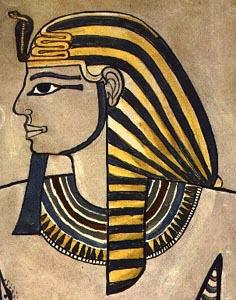Headscarf
This article needs additional citations for verification. (November 2020) |


A headscarf is a scarf covering most or all of the top of a person's, usually women's, hair and head, leaving the face uncovered. A headscarf is formed of a triangular cloth or a square cloth folded into a triangle, with which the head is covered.[1]
Purposes
[edit]
Headscarves may be worn for a variety of purposes, such as protection of the head or hair from rain, wind, dirt, cold, warmth, for sanitation, for fashion, recognition or social distinction; with religious significance, to hide baldness, out of modesty, or other forms of social convention.[2] Headscarves are now mainly worn for practical, cultural or religious reasons.
Until the latter 20th century,[3] headscarves were commonly worn by women in many parts of Europe, Southwestern Asia, North Africa, and the Americas, as well as some other parts of the world. In recent decades, headscarves, like hats, have fallen out of favor in Western culture. They are still, though, common in many rural areas of Eastern Europe as well as many areas of the Middle East and the Indian subcontinent.[4]
The Christian Bible, in 1 Corinthians 11:4–13, enjoins women to wear a head covering.[5] Among Anabaptist Christians, this often takes the form of a Kapp or hanging veil—being worn throughout the day.[6] For Eastern Orthodox Christians, headscarves are traditionally worn by women while attending the church, and historically, in the public as well. However, in certain localities, this has waned.[7][8][9]
A form of headscarf, known as the hijab, is often seen in Muslim countries and is born out of tradition. It is worn by some Muslim women who consider it to be a religious ordainment, and its style varies by culture.[10] Not all Muslims believe that the hijab in the context of head covering is a religious ordainment in the Quran.[11][12]
For fashion and ceremonial usage, the gele is a traditional headscarf of Yoruba women for fashionable purposes.
Religious use
[edit]Headscarves may specifically have a religious significance or function, or be expected as a matter of social custom, the two very often being confused.[citation needed]
Judaism
[edit]Judaism, under Halakhah (Jewish Law), promotes modest dress among women and men. Many married Orthodox Jewish women wear a headscarf (mitpahat or tichel), snood, turban, shpitzel or a wig to cover their hair. The Tallit is commonly worn by Jewish men, especially for prayers, which they use to cover their heads in order to recite the blessings, although not all men do this. It also may not apply to the entire prayer service, sometimes only specific sections such as the Amidah. The Kohanim (priests) also cover their heads and shoulders with the tallit during the priestly blessing, so as to conform to Halakah which states that the hands of the priests should not be seen during this time as their mystical significance to the hand position.
Christianity
[edit]

The Bible, in 1 Corinthians 11:4–13, instructs women to wear a head covering, while men are to pray and worship with their heads uncovered.[13][14] In the early Church, Christian head-covering with an opaque cloth veil was universally taught by the Church Fathers and practiced by Christian women.[15][3][16][17][18] The practice continues in many parts of the world, such as Romania, Russia, Ukraine, Ethiopia, India, Pakistan, and South Korea.[19]
The Early Church Father John Chrysostom (c. 347 – 407) delineated Saint Paul's teaching, explaining that Paul said a man praying with a head covering "dishonoureth his head", while Christian women should always wear a cloth head covering. Paul compared a woman not wearing a veil to her being shaven, which Chrysostom stated is "always dishonourable".[7][20]
The Church Fathers taught that because the hair of a woman has sexual potency, it should only be for her husband to see and covered the rest of the time.[21] To some extent, the covering of the head depended on where the woman was, but it was usually outside and on formal occasions, especially when praying at home and worshipping in church.[19][22] Certain styles of Christian head coverings were an indication of married status; the "matron's cap" is a general term for these.[13]
Many Anabaptist Christian women (Amish/Para-Amish, Schwarzenau Brethren, Bruderhof, Hutterites, River Brethren, Apostolic Christians, Charity Christians and Mennonites) wear their headscarf at all times, except when sleeping; these head coverings are usually in the form of a hanging veil or kapp.[23][6]
In countries with large Eastern Orthodox Christian population such as Romania[24] or Russia[25] headscarves and veils are used by Christian women in the Eastern Orthodox Church, Oriental Orthodox Church, Assyrian Church of the East, and Roman Catholic Church.[26][27] A few years back, all women in Russia who attended Divine Liturgy wore head-coverings. A woman having her head covered means that she honors the Lord. Head-coverings also symbolizes that a woman is married and that her husband is the head of the family. Little girls also have their heads covered when they go to Mass at church, not because they are married, but in order to honor the Lord. Today, young Russian Orthodox women and little girls still cover their heads when going to church, although it differs in style from those worn by women of older age (grandmothers).[citation needed]
The Roman Catholic Church required all women to wear a head covering over their hair in church until the 1980s; in Spain, these take the form of the mantilla. Women meeting the Pope in formal audiences are still expected to wear them. Martin Luther, the German Reformer, as well as John Calvin, a major figure in the Reformed Churches, also expected women to cover their heads in church, as did John Wesley, the founder of the Methodist Churches.[28]
In many rural areas, women, especially widows, continue to observe the traditional Christian custom of head-covering, especially in the Mediterranean, as well as in eastern and southern Europe; in South Asia, it is common for Christian women to wear a head covering called a dupatta.[29][19] At times the styles of covering using simple cloth became very elaborate, with complicated layers and folding, held in place with hair pins. Among the many terms for head-coverings made of flexible cloth are wimple, hennin, kerchief, gable hood, as well as light hats, mob caps and bonnets.[citation needed] Some English speakers use the word "babushka" (the word for "grandma" in Russian: ) to indicate a headscarf tied below the chin, as still commonly worn in rural parts of Europe. In many parts of Europe, headscarves are used mainly[citation needed] by elderly women, and this led to the use of the term "babushka", an East Slavic word meaning "grandmother". Some types of head coverings that Russian women wear are: circlet, veil, and wimple.
Islam
[edit]Islam promotes modest dress among men and women. According to some, it is the "khimar"[30] mentioned in the Quran. Many of these garments cover the hair, ears and throat, but do not cover the face. Not all Muslims believe that the hijab in the context of head-covering is a religious ordainment in the Quran.[11][12]
The keffiyeh is commonly used by Muslims in Middle Eastern countries.[31]
Headscarves and veils are used by some Muslim women and girls, so that no one has the right to expose her beauty but except her Mahrams.[32] For women, the Muslim religious dress varies, and various cultures include hijab, burqa, chador, niqab, dupatta, or other types of hijab, while others reject all of these dress codes. The religion prescribes modest behaviour or dress in general.[33]
Sikhism
[edit]Young Sikhs often wear a cloth wrapping to cover their hair, before moving on to the dastar. Older Sikhs may wear them as an under-turban.[citation needed]
Use while working
[edit]


Practical reasons for headscarf use at work include protection from bad weather and protection against industrial contamination, for example in dusty and oily environments. A headscarf can ensure that the hair does not interfere with the work and get caught-up in machinery since long hair can get into rotating parts of machines, so this is avoided either by means of a suitable head covering like a cap, hairnet or kerchief; cutting the hair short; or by putting on a headscarf. Hygiene also requires wearing a head cover at some workplaces, for example in kitchens and hospitals. Such usage has gone on since about 1900, when women's use of mob caps and Dutch bonnets declined.
Workers wore them at work to protect their hair from dirt. Farmers used them to see off the weather and dirt. Soviet labour units of the 1930s and 1940s wore them as part of their uniform (where uniforms were available). This habit was common until about the 1950s in the West for farmers and 1960s factory workers, and 1970s in the former USSR for farmers and factory workers.
In popular culture
[edit]In the modern era, persons may choose to wear a headscarf for religious, moral, or practical reasons.
Hilda Ogden, popular character from the UK soap opera Coronation Street portrayed by Jean Alexander, became famous throughout the nation for combining a headscarf with hair curlers. So famous was she that, in 1982, she came fourth behind the Queen Mother, Queen Elizabeth II, and Diana, Princess of Wales in a poll of the most recognisable women in Britain.[34]
Image gallery
[edit]-
Amenhotep II in a Nemes headcloth
-
An early 19th-century Russian silk embroidered headscarf[35]
-
Oil on canvas painting by Vittore Ghislandi, called Fra Galgario
-
A woman selling flowers in Egypt, 1906
-
Egypt, 1935
-
School girls in Herat, Afghanistan
-
At a Tridentine Mass, women typically wear a headcovering.
-
Assyrian Christian women wearing headcoverings and modest clothing praying in Mart Maryam Church in Urmia, Iran
-
Three Turkish women wearing headscarves, 2003
-
Women typical dress and headscarf; Nazaré, Portugal, 2006
-
A headscarf for chefs; Los Angeles, 2007
-
Laughing woman in Kuala Lumpur wearing a blue headscarf, 2008
-
An Afghan girl wears an Islamic style scarf at the International Women's Day celebration in Pajshir in 2008.
-
Girls dressed up for a parade wear matching yellow headscarves. 2009, New Orleans, Louisiana.
-
A Malaysian girl wearing a headscarf, 2010
-
Woman with a headscarf in Gambia
-
A Jewish woman wearing a headwrap
-
Scarved Moksha girls in traditional costumes
-
Yoruba Women in Gele, a traditional headscarf (Iborun) of Yoruba ladies
-
Salvadoran women wear distinctive regional veils for national celebrations.
-
A young Somali woman in a traditional headscarf
-
A Chinese man with headscarf in his fashion costume
-
A cancer patient in a head scarf after losing her hair due to chemotherapy
See also
[edit]- Kerchief
- Christian headcovering
- Head tie
- Headscarf controversy in Turkey
- Islamic dress in Europe
- Mathabana
- Shalwar Kameez
- Tichel
- Turban
- Veil
References
[edit]- ^ Amber Nicole Alston (8 January 2021). "Conservative, rebellious, culture-defining: A brief history of the headscarf". CNN. Retrieved 3 March 2022.
- ^ Rosalie Gilbert. "Veils and Wimples". Rosalie's Medieval Woman. Retrieved 2 January 2023.
- ^ a b Gordon, Greg (31 August 2015). "Are Head Coverings Really for Today?". Evangelical Focus. Retrieved 2 May 2022.
One of the most questioned practices in the New Testament in the modern day Western Church is the practice of Head Coverings for women. Yet to get perspective we need to look over the panoply of God's Church for 2000 years and see that this is not something new but old—and has been practiced diligently over the ages. It is hard to imagine but since the 1960s the Church almost entirely practiced this tradition. The influence of secular reasoning, feminism and liberal theology have led to the questioning and, ultimately, the casting aside of this practice in the Church at large in the evangelical world.
- ^ Flinn, Isabella (2014). Pinpricks in the Curtain: India Through the Eyes of an Unlikely Missionary. WestBow Press. p. 234. ISBN 9781490834313.
- ^ Hunt, Margaret (2014). Women in Eighteenth Century Europe. Taylor & Francis. p. 58. ISBN 9781317883876.
Today many people associate rules about veiling and headscarves with the Muslim world, but in the eighteenth century they were common among Christians as well, in line with 1 Corinthians 11:4-13 which appears not only to prescribe headcoverings for any women who prays or goes to church, but explicitly to associate it with female subordination, which Islamic veiling traditions do not typically do. Many Christian women wore a head-covering all the time, and certainly when they went outside; those who did not would have been barred from church and likely harassed on the street. … Veils were, of course, required for Catholic nuns, and a veil that actually obscured the face was also a mark of elite status throughout most of Europe. Spanish noblewomen wore them well into the eighteenth century, and so did Venetian women, both elites and non-elites. Across Europe almost any woman who could afford them also wore them to travel.
- ^ a b Scott, Stephen (1996). Introduction to Old Order and Conservative Mennonite Groups: People's Place Book No. 12. Simon and Schuster. ISBN 978-1-68099-243-4.
- ^ a b "On Account of the Angels: Why I Cover My Head". Orthodox Christian Information Center. Retrieved 8 April 2022.
St. John Chrysostom thought that Paul, in admonishing women to wear a covering "because of the angels," meant it "not at the time of prayer only, but also continually, she ought to be covered." Fr. Rhodes agrees: "The veil can be the constant symbol of the true woman of God … a way of life … a testimony of faith and of the salvation of God, not only before men, but angels as well."
- ^ Yegorov, Oleg (11 December 2019). "Why do women cover their heads in Orthodox churches?". www.rbth.com. Retrieved 6 December 2020.
- ^ Barbara Weiß (12 July 2016). "Religion und Glaube in Bayern: Orthodoxe Kirche". Bayerischer Rundfunk (in German). Archived from the original on 17 November 2018.
- ^ Sparrow, Mary (9 July 2018). "Understanding the Veil: A Primer in Muslim Women's Head Coverings [Photo Gallery]". International Mission Board. Archived from the original on 9 July 2018.
- ^ a b Ibrahim B. Syed. "The Qur'an Does Not Mandate Hijab". Islamic Research Foundation International. Archived from the original on 21 December 2015. Retrieved 26 December 2015.
- ^ a b Jamal Saidi. ""Hijab is not an Islamic Duty" – Scholar". Moroccoworldnews.com. Archived from the original on 27 December 2015.
- ^ a b Hunt, Margaret (2014). Women in Eighteenth Century Europe. Taylor & Francis. p. 58. ISBN 9781317883876.
- ^ Safran, Linda (2014). The Medieval Salento: Art and Identity in Southern Italy. University of Pennsylvania Press. p. 112. ISBN 9780812245547.
- ^ Bercot, David W. (1992). Common Sense: A New Approach to Understanding Scripture. Scroll Publishing Co. p. 68. ISBN 978-0-924722-06-6.
Hippolytus, a leader in the church in Rome around the year 200, compiled a record of the various customs and practices in that church from the generations that preceded him. His Apostolic Tradition contains this statement: "And let all the women have their heads covered with an opaque cloth, not with a veil of thin linen, for this is not a true covering." This written evidence of the course of performance of the early Christians is corroborated by the archaeological record. The pictures we have from the second and third centuries from the catacombs and other places depict Christian women praying with a cloth veil on their heads. So the historical record is crystal clear. It reveals that the early generation of believers understood the head covering to be a cloth veil—not long hair.
- ^ "Veil". Early Christian Dictionary. Retrieved 7 September 2021.
- ^ Earle, Alice Morse (1903). Two Centuries of Costume in America, Vol. 2 (1620–1820). The Macmillan Company. p. 582.
One singular thing may be noted in this history, – that with all the vagaries of fashion, woman has never violated the Biblical law that bade her cover her head. She has never gone to church services bareheaded.
- ^ "The Ultimate Guide to Christian Head Coverings". Saint John the Evangelist Orthodox Church. 26 October 2021. Retrieved 25 January 2022.
- ^ a b c Mingus, Elaine (19 May 2015). "Christian Headcovering in India". The Head Covering Movement.
There were many times that a woman would be called into prayer while preparing a meal. Instead of running to get a head scarf, she would grab a readily available dish towel to cover her head instead.
- ^ Schaff, Philip (1889). A Select Library of the Nicene and Post-Nicene Fathers of the Christian Church: St. Chrysostom: Homilies on the Epistles of Paul to the Corinthians. The Christian Literature Company. p. 152.
Well then: the man he compelleth not to be always uncovered, but only when he prays. "For every man," saith he, "praying or prophesying, having his head covered, dishonoureth his head." But the woman he commands to be at all times covered. Wherefore also having said, "Every woman that prayeth or prophesieth with her head unveiled, dishonoureth her head," he stayed not at this point only, but also proceeded to say, "for it is one and the same thing as if she were shaven." But if to be shaven is always dishonourable, it is plain too that being uncovered is always a reproach. And not even with this only was he content, but he added again, saying, "The woman ought to have a sign of authority on her head, because of the angels." He signifies that not only at the time of prayer, but also continually, she ought to be covered. But with regard to the man, it is no longer about covering but about wearing long hair, that he so forms his discourse. To be covered he then only forbids, when a man is praying; but the wearing of long hair he discourages at all times.
- ^ Milliken, Roberta (2020). A Cultural History of Hair in the Middle Ages. Bloomsbury Publishing. p. 54. ISBN 978-1-350-10303-0.
- ^ Françoise Piponnier and Perrine Mane; Dress in the Middle Ages; pp. 40, 78–81, 95, 121, Yale UP, 1997; ISBN 0300069065
- ^ Almila, Anna-Mari; Inglis, David (2017). The Routledge International Handbook to Veils and Veiling. Taylor & Francis. p. 296. ISBN 9781317041146.
- ^ "Women's Headcoverings" (blog). The Orthodox Life. 4 February 2014. Retrieved 14 April 2018.
- ^ Bercot, David. "Head Covering Through the Centuries". Scroll Publishing Co. Retrieved 2 January 2023.
- ^ Elisabet (Spring 1997). "On Account of the Angels: Why I Cover My Head". The Handmaiden. Conciliar Press. Retrieved 2 January 2023 – via orthodoxinfo.com.
- ^ "Veiling in Church: Mantilla Manifesto" Archived 7 April 2014 at the Wayback Machine. altcatholicah.com
- ^ Wesley, John (1987). Wesley's Notes on the Bible. Christian Classics Ethereal Library. p. 570. ISBN 9781610252577.
- ^ Boultwood, Anne; Hindle, Sian (8 February 2018). Culture, Costume and Dress. Gold Word Publishing. p. 80. ISBN 9781909379268.
- ^ "Veiling in Qur'anic Verses | Muslim Sexual Ethics | The Feminist Sexual Ethics Project | Brandeis University". www.brandeis.edu. Retrieved 27 April 2024.
- ^ Sottile, Zoe (28 November 2023). "The Palestinian keffiyeh explained: How this scarf became a national symbol". CNN. Retrieved 27 April 2024.
- ^ "Veiling in Qur'anic Verses | Muslim Sexual Ethics | The Feminist Sexual Ethics Project | Brandeis University". www.brandeis.edu. Retrieved 27 April 2024.
- ^ Sayyid Muhammad Rizvi (18 November 2021). "Why Hijab?". www.al-islam.org. Retrieved 2 January 2023.
- ^ Little, Daran (1995). The Coronation Street Story, p. 188. London: Boxtree. ISBN 1-85283-464-1
- ^ "Headscarf | Russian | The Met". The Metropolitan Museum of Art.
Further reading
[edit]- Anderson, Cory A. (2013). The Ornament of a Spirit: Exploring the Reasons Covering Styles Change. Stoneboro: Ridgeway Publishing.
- Anderson, Cory; Anderson, Jennifer (2019). Fitted to Holiness: How Modesty is Achieved and Compromised among the Plain People. Millersburg: Acorn Publishing.
- Bercot, David (2012). What the Early Christians Believed About the Head Covering. Amberson: Scroll Publishing Co.
- Bercot, David (1992). Common Sense: A New Approach to Understanding Scripture. Amberson: Scroll Publishing Co. ISBN 9780924722066.
- Ruth, Merle (2022). The Significance of the Christian Woman's Veiling. Harrisonburg: Christian Light Publications.
- Shank, Tom (1992). "…Let Her Be Veiled.": An in-depth study of 1 Corinthians 11:1–16. Eureka: Torch Publications.
- Williams, Paul K. (2005). The Head Coverings of I Corinthians 11 (PDF). Archived (PDF) from the original on 28 December 2018.
External links
[edit] Media related to Headscarves at Wikimedia Commons
Media related to Headscarves at Wikimedia Commons


![An early 19th-century Russian silk embroidered headscarf[35]](http://upload.wikimedia.org/wikipedia/commons/thumb/f/f0/Headscarf_MET_31.507_CP4.jpg/265px-Headscarf_MET_31.507_CP4.jpg)






















